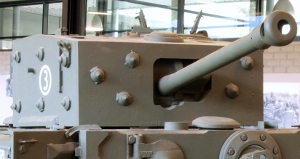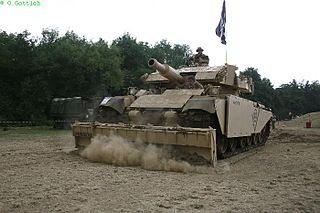 W
WThe Ordnance QF 3 pounder gun was a 47 mm British tank gun based on the Ordnance QF 3 pounder Vickers naval gun, mounted on Vickers Medium Tanks in the 1920s and 1930s. The gun was produced in 32 calibre and 40 calibre versions.
 W
WThe Ordnance QF 20 pounder was a British 84 mm (3.307 inch) tank gun. It was introduced in 1948 and used in the Centurion main battle tank, Charioteer medium tank, and Caernarvon Mark II heavy tank. The 20 pounder was designed to replace the Ordnance QF 17 pounder, which had proven itself effective in World War II. However, once the 20 pounder gun was found to have inadequate performance against the Soviet T-54, the gun was mostly replaced in service by the larger calibre 105 mm L7 gun.
 W
WThe Ordnance QF 32 pounder or (32-pdr) was a British 94 mm gun, initially developed as a replacement for the Ordnance QF 17-pdr anti-tank gun.
 W
WThe Ordnance QF 2-pounder, or simply "2 pounder gun", was a 40 mm (1.575 in) British anti-tank and vehicle-mounted gun employed in the Second World War.
 W
WOrdnance QF 3 inch howitzer was a howitzer fitted to British cruiser and infantry type tanks of the Second World War so they could fire a smoke shell in "close support" of other tanks or infantry. HE shells were also available. Earlier British tanks were fitted with a 3.7 in howitzer.
 W
WThe Ordnance QF 6-pounder 6 cwt Hotchkiss Mk I and Mk II was a shortened version of the original QF 6 pounder Hotchkiss naval gun, and was developed specifically for use in the sponsons of the later Marks of British tanks in World War I, from Mark IV onwards.
 W
WThe Ordnance Quick-Firing 17-pounder was a 76.2 mm (3 inch) gun developed by the United Kingdom during World War II. It was used as an anti-tank gun on its own carriage, as well as equipping a number of British tanks. Used with the APDS shot, it was capable of defeating all but the thickest armour on German tanks. It was used to 'up-gun' some foreign-built vehicles in British service, notably to produce the Sherman Firefly variant of the US M4 Sherman tank, giving British tank units the ability to hold their own against their German counterparts. In the anti-tank role, it was replaced after the war by the 120 mm BAT recoilless rifle. As a tank gun, it was succeeded by the 84 mm 20 pounder.
 W
WThe Ordnance QF 75 mm, abbreviated to OQF 75 mm, was a British tank-gun of the Second World War. It was obtained by boring out the Ordnance QF 6 pounder 57-mm anti-tank gun to 75-mm, to give better performance against infantry targets in a similar fashion to the 75mm M3 gun fitted to the American Sherman tank. The QF came from "quick-firing", referring to the use of ammunition with the shell and propellant in a single cartridge. The gun was also sometimes known as ROQF from Royal Ordnance Quick-Firing.
 W
WThe Ordnance QF 95-mm howitzer was a British howitzer built in two versions during the Second World War. The tank howitzer version was accepted for service use, but the infantry version was not.
 W
WThe Royal Ordnance L7, officially designated Gun, 105 mm, Tank, L7, is the basic model of the United Kingdom's most successful tank gun. The L7 is a 105 mm L/52 rifled design by the Royal Ordnance Factories intended for use in armoured fighting vehicles, replacing the earlier 20-pounder (84 mm) tank gun mounted on the Centurion tank. The successful L7 gun has been fitted on many armored vehicles including the British Centurion, the German Leopard 1 and early variants of the US M1 Abrams.
 W
WRoyal Ordnance L9 is a British short-barrelled 165 mm gun used for combat engineering, particularly the demolition of defences.
 W
WThe Royal Ordnance L11A5, officially designated Gun 120 mm Tk L11, is a 120 mm L/55 rifled tank gun design. It was the first of NATO's 120mm Main Battle Tank guns which became the standard calibre for Western tanks in the later period of the Cold War. By 2005, a total of 3,012 L11 guns were produced. List price was US $227,000 (1990).
 W
WThe L30A1, officially designated Gun 120 mm Tk L30, is a 120 mm rifled tank gun used by the British Army and Royal Army of Oman. It is fitted in the turret of the Challenger 2 main battle tank. It is an improved production model of the Royal Ordnance L11 series of rifled tank guns.